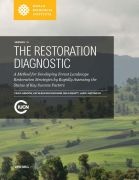The Restoration Diagnostic
December 2015

The Restoration Diagnostic is a three-step process for developing strategies for successful forest landscape restoration:
1. Users define the scope or geographic boundary within which to apply the diagnostic—such as a country, county, or watershed.
2. Users conduct an assessment to identify which key success factors are already in place—and which are not—within the landscape being considered for restoration.
3. Users identify which policies, incentives, and practices would address the missing factors.
When applied prior to initiating a restoration process, the diagnostic can help decision makers and stakeholders focus their efforts on getting the missing key success factors in place—before large amounts of human, financial, or political capital are invested. When applied periodically as landscape restoration progresses, the diagnostic can help decision makers and implementers sustain restoration progress through adaptive management. As a result, application of the diagnostic may increase the likelihood that forest landscape restoration processes will be successful.
The diagnostic can be used by mid-level managers—and analysts that support these managers—from organizations interested in encouraging forest landscape restoration. Government agencies—particularly those responsible for planning, forests, agriculture, environment, or rural development—comprise one key user group. Nongovernmental organizations that advocate for or help implement restoration are another. Landowners and communities (or their representatives) can use the diagnostic, as can development agencies and financial institutions considering financing forest landscape restoration programs. Furthermore, companies considering forest landscape restoration—such as those needing to meet legal requirements after extractive operations are completed—can use the diagnostic as a planning tool.
The diagnostic is a stand-alone tool as well as a component within the Restoration Opportunities Assessment Methodology (ROAM). ROAM provides guidance on identifying where forest landscape restoration is feasible or desirable; quantifying the benefits of restoration; and determining what types of restoration are most appropriate economically, socially, and ecologically for a particular place.